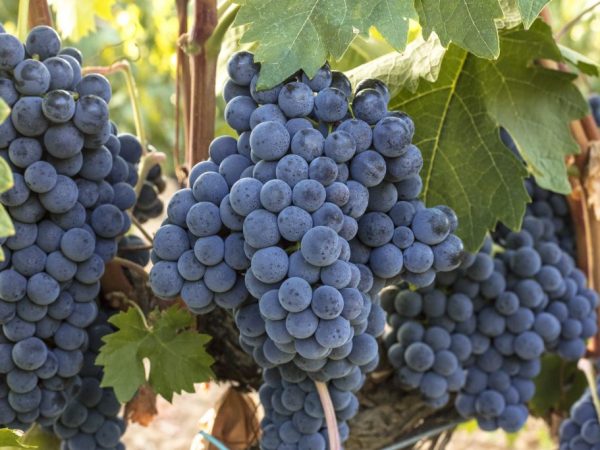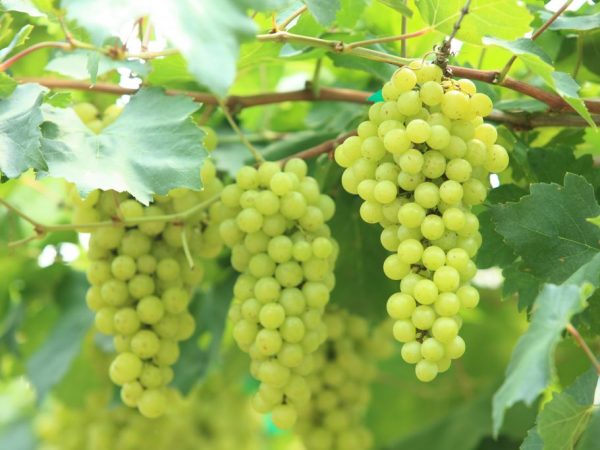Normalization of the number of brushes on grapes
Rationing of clusters on grapes makes it possible to regulate the quantitative and qualitative characteristics of the future harvest.

Normalization of the number of brushes on grapes
Purpose of rationing
The main purpose of rationing is to remove the load from the vine, which it cannot bear. When the berries are overloaded, much more is formed on the plant than it can provide with adequate nutrition for growth and development.
Table large-fruited varietal varieties are prone to excessive formation of the yield.
As a result, the harvest does not reach the sizes of berries and their taste provided for the varietal variety. Redirecting excess nutritional fruits to ripening leads to depletion of the plant and poor ripening of the vine and does not make it possible to prepare the garden culture for wintering in an adequate measure.
Time of rationing
The normalization of the number of berries in the vine is carried out before the beginning of the flowering stage, visually assessing the size and number of inflorescences on individual processes. The best option for an adult fruiting vine is early normalization with fully or partially formed inflorescences. In this case, all nutrition will begin to flow into the left bunches, and this has a positive effect on the size characteristics, preventing the outflow of nutrients to the berries, which will still have to be removed.
When determining the normalization time, they are guided by the rule: varieties with stable pollination are normalized at the stage of inflorescence formation, in young bushes with poor pollination quality in previous seasons, they regulate the load on the grape bush at the end of flowering.
For inexperienced winegrowers, it is effective to identify excess inflorescences during visual inspection immediately after the end of the flowering and pollination stage, when well-formed ovaries are visible.
Calculation of the number of bunches
When calculating the load on a grape bush, the following features are taken into account:
- term of technical maturation,
- average weight of bunches,
- the size of the berries obtained,
- winter hardiness,
- the length of the autumn pruning of the vine.
Together, these parameters help to determine the optimal normalization for the grape bush.
Mathematical approach
Some growers use the formula Magarach: M C * N, where M is the optimal number of eyes of a grape bush, N is the number of vigorous shoots, C is a correction factor taken as 2.5.
This formula is applicable when calculating the rate per bush, not by the future yield, but by the number of eyes. In this case, the correction factor takes into account losses. Among the disadvantages is the need to adjust the normalizing indicators after trimming the shoots.
Varietal approach

The norm of brushes depends on the variety
Most winegrowers determine the rate for a grape bush by varietal characteristics:
- for large-fruited table species of early ripeness with a bunch weight of 0.8 kg and large berries of 3.5 * 2.5 cm - at the rate of 1 per 1 shoot, with a large yield, such varieties ripen much longer,
- for table species with a bunch weight of up to 0.5 kg - at the rate of no more than 2 per 1 shoot,
- for technical species and table varieties with a bunch weight of up to 0.2 kg - 3 or more per shoot.
Varieties that have brushes of 1.5 kg or more are left sterile on every third shoot. Small brushes, kishmish varieties do not require normalization.
The older the vine, the larger the harvest it is able to withstand, but the number of clusters on the shoots is increased gradually, usually with a plus of half an additional cluster for each subsequent year.
Some varietal varieties are capable of forming clusters with an increased density of berries, as a result, the fruits inside do not ripen. Such clusters are normalized by thinning, removing up to 30% of the fruit.
Features of normalization
In the process of calculating the normalization of a poor grape harvest, some factors should be taken into account, the presence of which requires a decrease in the weight attributed to grape shoots.
The soil
When growing large-fruited varieties, in the process of calculating the rationing of grapes with bunches, the saturation of the soil with phosphorus and potassium is taken into account, which are able to provide adequate nutrition for the number of brushes selected during rationing. If the bioactivity of the soil is at the stage of formation, it is recommended to leave no more than 1 brush per 1 shoot on grown table large-fruited varietal varieties.
Frost resistance of the variety
For the subsequent successful wintering of the plant, a frost resistance limit of the varietal variety of -21 ° C is required. In the absence of such a characteristic, to ensure the number of elements required for the winter, the load on the grape bush is reduced in relation to the empirically calculated indicators and the number of brushes is left less than it should be according to the calculation.
Conclusion
The normalization of the load on the grape bush ensures the timely onset of the ripening of the berries and the complete ripening of the vine before the onset of cold weather. It is used depending on the regional climate, soil fertility and cultivated variety.


